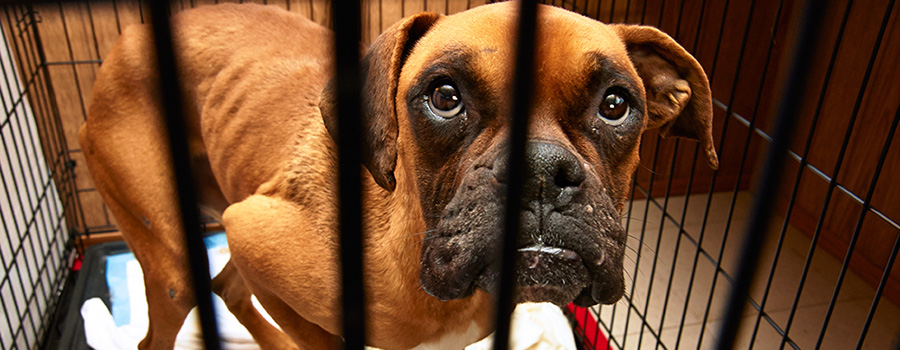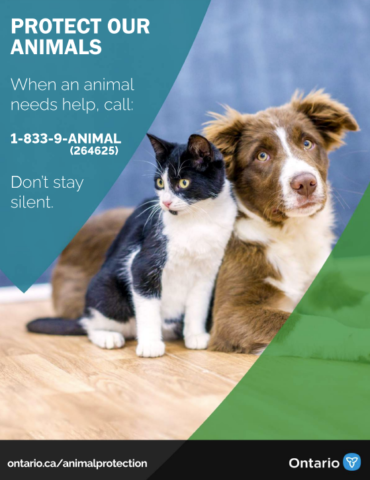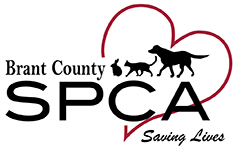
What is Animal Cruelty?
Animal cruelty generally falls into two categories: neglect, or intentional cruelty. Neglect is the failure to provide adequate water, food, shelter, or necessary care. Examples of neglect include: starvation, dehydration, inadequate shelter, parasite infestations, failure to seek veterinary care when an animal is in need of medical attention, allowing a collar to grow into an animal’s skin, confinement without adequate light, ventilation, space or in unsanitary conditions; and failure to trim nails resulting in excessive growth. Equally disturbing as neglect is the brutality of intentional cruelty, involving deliberate physical harm or injury inflicted on an animal. Regretfully, cases of animals being beaten, burned, poisoned or stabbed to death are not uncommon. In some cases neglect or cruelty is the result of people using animals as tools for commercial profit, such as in the cases of puppy mills, dog fighting, cock fighting and illegal slaughterhouses.
How to Recognize Animal Cruelty
Look for these common signs of neglect or intentional cruelty witnessed by Ontario SPCA investigators:
- Wounds on the body.
- Severely overgrown nails (often curling under) or hooves (often curling upwards).
- Patches of missing hair.
- Extremely thin, starving animals with ribs or backbone protruding.
- Infected eyes that have been left untreated.
- Limping.
- Animals who are repeatedly left alone without food and water. Often they are chained up in a yard.
- Animals who have been hit by cars and have not received veterinary attention.
- Animals who are kept outside without shelter in extreme weather conditions. Tropical birds especially cannot tolerate cold temperatures.
- An owner kicking, hitting or physically abusing an animal.
- Animals who cower fearfully or act aggressively when their owners approach.
- Severe flea or tick infestations left untreated.
- Animals left in a car on a hot or cold day.
- Animals crammed into tiny cages in overcrowded conditions.
- Abandonment (often when pet owners move or by unprofitable farmers).
- Reptiles with dull, darkened skin, tremors, gaping mouth and excessive saliva, or experiencing difficulty climbing.
- Aquatic and amphibious creatures kept in tanks with murky water.
- Illegal trapping of wild animals or animals left for extended periods in traps.
- Excessive scratching of the head area, shaking of the head and dirt or discharge in ears indicative of a possible ear infection.
- Chronic diarrhea or vomiting.
- Animals kept in dirty conditions including being forced to stand in their own urine and excrement.
- Swellings, such as tumors or abscesses, left untreated.
- Rabbits with a severe head tilt.
- Slaughter by untrained individuals.
Reporting Animal Cruelty
The Provincial Animal Welfare Services Act, 2019 (PAWS Act) came into force on January 1, 2020, replacing the Ontario Society for the Prevention of Cruelty to Animals Act. The PAWS Act and its regulations aim to ensure that all animals are protected and treated in a humane manner including:
- Enabling a fully provincial government-based welfare services model
- Enabling courts to impose the strongest financial penalties for offenders in Canada
- Updated prohibitions and obligations, such as prohibiting harming or attempting to harm a service animal
- Established a process for members of the public to make complaints about the conduct of inspectors that offers increased transparency and accountability
Who to Call
To report suspected animal abuse in Brantford or Brant County, please call the PAWS Act hotline at 1-833-9-ANIMAL (264625) or contact Crime Stoppers at 1-800-222-TIPS (8477).
The information provided in this section is compiled from the animal protection section of the ontario.ca website. For more information, please click here.
